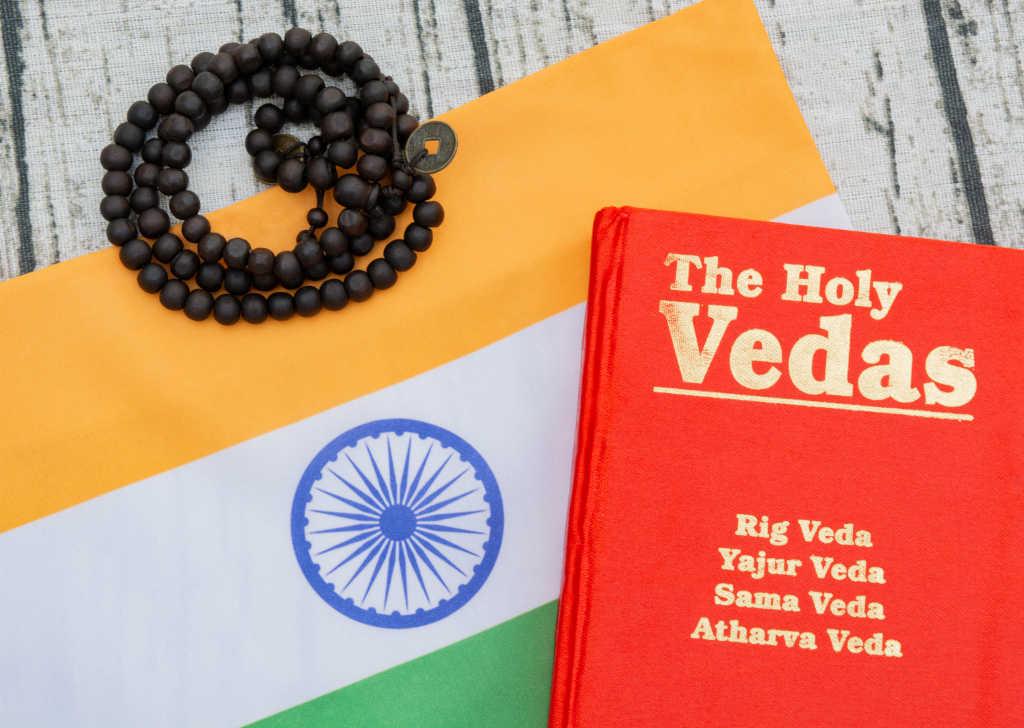The Vedas

The word Veda in Sanskrit means knowledge. It is derived from ‘vid,’ which in Sanskrit means to know. The sacred Vedic knowledge is said to have been revealed to the Rishis. There is no human author of the Vedic knowledge. Instead, they transferred this divine knowledge to their disciples and descendants by oral instruction.
‘Veda’ is a collection of four literary works. Each Veda comprises several volumes or ‘Mandalas’ that contain hymns or ‘Suktas’ and mantras.
The four Veda are:
- Rigveda
- Yajurveda
- Samaveda
- Atharvaveda.
Each of these four is a collection of four types of works:
- Samhitas
- Brahmanas
- Aranyakas
- Upanishads
The Upanishads are the latest addition to the Vedas. They are often very short, comprising a few Shlokas only. Vedanta, which means the final part of Veda, is primarily based on the teachings from the Upanishads.
Rigveda
Rigveda is the oldest of Vedas. The Samhitas form the core text comprising ten mandalas containing 1028 hymns (sūktas). The hymns are primarily dedicated to describing the rites and rituals in the praise and worship of the deities. Rigveda also contains sections on cosmology, metallurgy, and medicine. Rigveda describes the origin of the universe and the connection to the Supreme Reality, Brahman.
The principal Upanishad from RigVeda is the Aitareya Upanishad.
Yajurveda
Yajurveda is dedicated to rituals used to worship the deities. It is derived from ‘Yajus,’ which in Sanskrit means worship. Yajurveda builds upon the foundation of verses that are found in Rigveda.
The principal Upanishads from Yajurveda are:
- Brihadaranyaka Upanishad
- Isha Upanishad
- Taittiriya Upanishad
- Katha Upanishad
- Shvetashvatara Upanishad
- Maitrayaniya Upanishad
Samaveda
Samaveda is dedicated to the melodies and chants. Samaveda is always recited. The Ragas of Indian music are said to originate from Samaveda. Since the gods revealed the Vedas to the Rishis, the Ragas are also considered divine. It is no wonder Indian classical music is beyond comparison.
The principal Upanishads from Samaveda are:
- Chandogya Upanishad
- Kena Upanishad
Atharvaveda
The Atharvaveda, in a way, deviates from the type of content that is there in the first three Vedas. Instead, Atharvaveda consists of prayers, spells, hymns, and charms to protect or enhance daily lives. These matters included the preservation of the crops that sustained life. Atharvaveda also includes the hymns and chants used as part of celebrations and rituals associated with marriage, initiation, and death.
The principal Upanishads from Atharvaveda are:
- Mundaka Upanishad
- Mandukya Upanishad
- Prashna Upanishad
The Upavedas
Each Veda is also associated with ‘Upaveda,’ which means applied knowledge. According to Caraṇavyuha, the four Upveda are:
- Ayurveda, associated with RigVeda.
- Dhanurveda, associated with Yajurveda
- Gāndharvaveda, associated with Samaveda
- Arthaśāstra, associated with Atharvaveda.